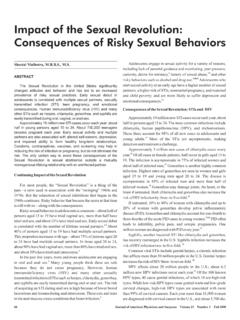Transcription of Isolation Forest - Nanjing University
1 Isolation Forest Fei Tony Liu, Kai Ming Ting Zhi-Hua Zhou Gippsland School of Information Technology National Key Laboratory Monash University , Victoria, Australia for Novel Software Technology Nanjing University , Nanjing 210093, China Abstract anomalies. Notable examples such as statistical methods [11], classification-based methods [1], and clustering-based Most existing model-based approaches to anomaly de- methods [5] all use this general approach. Two major draw- tection construct a profile of normal instances, then iden- backs of this approach are: (i) the anomaly detector is opti- tify instances that do not conform to the normal profile as mized to profile normal instances, but not optimized to de- anomalies.
2 This paper proposes a fundamentally different tect anomalies as a consequence, the results of anomaly model-based method that explicitly isolates anomalies in- detection might not be as good as expected, causing too stead of profiles normal points. To our best knowledge, the many false alarms (having normal instances identified as concept of Isolation has not been explored in current liter- anomalies) or too few anomalies being detected; (ii) many ature. The use of Isolation enables the proposed method, existing methods are constrained to low dimensional data iForest, to exploit sub-sampling to an extent that is not fea- and small data size because of their high computational sible in existing methods, creating an algorithm which has a complexity.
3 Linear time complexity with a low constant and a low mem- This paper proposes a different type of model-based ory requirement. Our empirical evaluation shows that iFor- method that explicitly isolates anomalies rather than profiles est performs favourably to ORCA, a near-linear time com- normal instances. To achieve this, our proposed method plexity distance-based method, LOF and Random Forests in takes advantage of two anomalies' quantitative properties: terms of AUC and processing time, and especially in large i) they are the minority consisting of fewer instances and data sets. iForest also works well in high dimensional prob- ii) they have attribute-values that are very different from lems which have a large number of irrelevant attributes, those of normal instances.
4 In other words, anomalies are and in situations where training set does not contain any few and different', which make them more susceptible to anomalies. Isolation than normal points. We show in this paper that a tree structure can be constructed effectively to isolate every single instance. Because of their susceptibility to Isolation , 1 Introduction anomalies are isolated closer to the root of the tree; whereas normal points are isolated at the deeper end of the tree. This Anomalies are data patterns that have different data char- Isolation characteristic of tree forms the basis of our method acteristics from normal instances. The detection of anoma- to detect anomalies, and we call this tree Isolation Tree or lies has significant relevance and often provides critical ac- iTree.
5 Tionable information in various application domains. For The proposed method, called Isolation Forest or iFor- example, anomalies in credit card transactions could signify est, builds an ensemble of iTrees for a given data set, then fraudulent use of credit cards. An anomalous spot in an as- anomalies are those instances which have short average path tronomy image could indicate the discovery of a new star. lengths on the iTrees. There are only two variables in this An unusual computer network traffic pattern could stand method: the number of trees to build and the sub-sampling for an unauthorised access. These applications demand size. We show that iForest's detection performance con- anomaly detection algorithms with high detection perfor- verges quickly with a very small number of trees, and it mance and fast execution.
6 Only requires a small sub-sampling size to achieve high de- Most existing model-based approaches to anomaly de- tection performance with high efficiency. tection construct a profile of normal instances, then iden- Apart from the key difference of Isolation versus pro- tify instances that do not conform to the normal profile as filing, iForest is distinguished from existing model-based [11, 1, 5], distance-based [6] and density-based methods [4]. in the follow ways: The Isolation characteristic of iTrees enables them to build partial models and exploit sub-sampling to an extent that is not feasible in existing methods. Since a large part of an iTree that isolates normal points is not needed for anomaly detection; it does not need to be constructed.
7 A small sample size produces better iTrees because the swamping and masking effects are reduced. (a) Isolating xi (b) Isolating xo iForest utilizes no distance or density measures to de- tect anomalies. This eliminates major computational cost of distance calculation in all distance-based meth- ods and density-based methods. iForest has a linear time complexity with a low constant and a low memory requirement. To our best knowledge, the best-performing existing method achieves only approximate linear time complexity with high memory usage [13]. iForest has the capacity to scale up to handle extremely large data size and high-dimensional problems with a large number of irrelevant attributes.
8 This paper is organised as follows: In Section 2, we demonstrate Isolation at work using an iTree that recursively partitions data. A new anomaly score based on iTrees is also proposed. In Section 3, we describe the characteristic of this method that helps to tackle the problems of swamping and masking. In Section 4, we provide the algorithms to con- (c) Average path lengths converge struct iTrees and iForest. Section 5 empirically compares this method with three state-of-the-art anomaly detectors;. we also analyse the efficiency of the proposed method, and Figure 1. Anomalies are more susceptible to report the experimental results in terms of AUC and pro- Isolation and hence have short path lengths.
9 Cessing time. Section 6 provides a discussion on efficiency, Given a Gaussian distribution (135 points), and Section 7 concludes this paper. (a) a normal point xi requires twelve random partitions to be isolated; (b) an anomaly xo re- 2 Isolation and Isolation Trees quires only four partitions to be isolated. (c). averaged path lengths of xi and xo converge In this paper, the term Isolation means separating an in- when the number of trees increases. stance from the rest of the instances'. Since anomalies are few and different' and therefore they are more susceptible to Isolation . In a data-induced random tree, partitioning of instances are repeated recursively until all instances are iso- To demonstrate the idea that anomalies are more suscep- lated.
10 This random partitioning produces noticeable shorter tible to Isolation under random partitioning, we illustrate paths for anomalies since (a) the fewer instances of anoma- an example in Figures 1(a) and 1(b) to visualise the ran- lies result in a smaller number of partitions shorter paths dom partitioning of a normal point versus an anomaly. We in a tree structure, and (b) instances with distinguishable observe that a normal point, xi , generally requires more attribute-values are more likely to be separated in early par- partitions to be isolated. The opposite is also true for the titioning. Hence, when a Forest of random trees collectively anomaly point, xo , which generally requires less partitions produce shorter path lengths for some particular points, then to be isolated.








